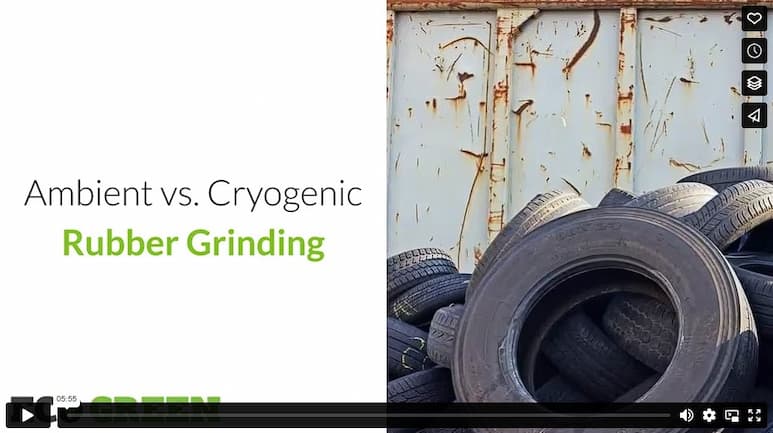Tire grinding for recycling was first developed in Minnesota in 1985. It began as a mechanical process to break down the tires and separate the useable rubber from the metal and fabric components of the tire. Similar to the way an office paper shredder destroys documents, these shredders cut the rubber into smaller pieces. By weight, a typical tire is 70% recoverable rubber. The rest is steel, fibers, and fillers. When recycled, a standard passenger tire will yield 10-12 pounds of rubber after filtering out the other materials.
Regardless of the final method used, all three primary grinding processes start the same way. Mechanical, ambient temperature grinding is the only method that can take a full-size tire and break it down into smaller pieces that can be fed into other machinery for further processing. After this initial break down step, there are three primary grinding methods that tire recyclers use.
- Ambient temperature grinding – the first method developed, this type of grinding is the most common. It is a multi-step process using a series of granulators and cracker mills interspersed with magnets (to remove steel) and air separators (to remove fibers). These machines can process the rubber from large pieces down to crumb rubber that is 20-30 mesh or 600 microns in size.
- Micro milling – a wet process, usually using water, that can grind rubber much smaller than traditional methods (40 mesh and smaller). Because the rubber is ground in fluid, usually water, it produces a clean, washed product. This process, however, is patented and can only be used by those who own rights to the patent.
- Cryogenic grinding – starting with rubber that has been coarse ground to two-inch minus, it can produce a fine grind, ¼ inch minus to 30 mesh, in fewer steps at a rate of 4,000-6,000 pounds per hour. In this method, liquid nitrogen is used to freeze the rubber, which is then “shattered” as it passes through a hammer mill. At temperatures well below freezing, the rubber breaks along smooth lines giving the surface a much more uniform texture.
Each grinding method requires different equipment and materials and produces a slightly different product, giving each advantages and disadvantages. The process that is best to use is the one that will provide the product that the customer wants. In many cases, contractors may not care as much about the type of rubber that they are buying as they do about its cost.
While most recycled rubber still ends up as tire derived fuel, another major product is crumb rubber. Crumb rubber consists of rubber that has been ground down to 3/8 inch or smaller.
What are the differences in ambient and cryogenically ground rubber crumb?
The biggest difference is the shape of the individual pieces of rubber that are produced in each method of grinding.
When rubber is ground at ambient temperatures, it still maintains the characteristics of rubber. Being somewhat pliable as it passes through the shredders, the edges of the cuts are rough. These rough edges affect the properties of the rubber. For example, for use in Rubber Modified Asphalt, ambient cut crumb rubber is preferred. The rugged edges of the rubber crumb give it more surface area to bond to the asphalt with which it is mixed.
When using the cryogenic process, recyclers spray the rubber or submerge it in liquid nitrogen. At temperatures below -112F, the rubber no longer acts like rubber. It acts more like glass. When hit in the hammer mill, the rubber shatters along smooth, straight lines.
These smooth particles that appear shiny are less prone to hold air bubbles when submerged in water. These particles are also better for mixing with sand as infill. They form a more stable connection and foundation with the silica sand. For this reason, cryogenically ground rubber is preferable for use in athletic fields. When rain falls on the artificial turf, ambient ground rubber has a tendency to float and move around in the water. This movement can create an uneven playing surface that may even contain potholes, creating a dangerous situation for players using the field.
Cryogenic grinding comes at a cost, however. Liquid nitrogen, while common and easily attainable, can cost a recycling company 2 to 6 cents per pound of rubber, depending on the desired rubber particle size and the quantity purchased.
Which rubber crumb is best?
With the many varied uses of rubber crumb, it is clear that no one grinding method is best for every situation. For many companies and applications, the best product will be the one that is the cleanest, highest quality rubber that fits in the project budget. There are not currently industry standards governing rubber crumb quality. However, there are the key components to look at when determining the best crumb rubber for any job. Rubber with low metal, fiber and moisture content is best.
At EcoGreen Equipment, we offer tire shredding equipment that can grind rubber to all different sizes and specifications to help you produce the best product. From our Eco Green Giant that produces 2 to 6 inch shreds to our Eco Krumbuster, which can produce rubber crumb or powder smaller than 850 microns that is 99.9% free of wires and fibers, we have your needs covered.
Video





